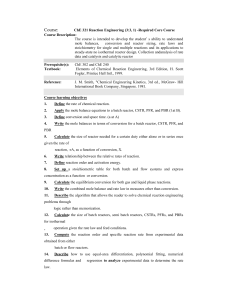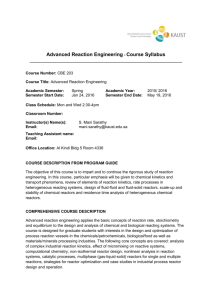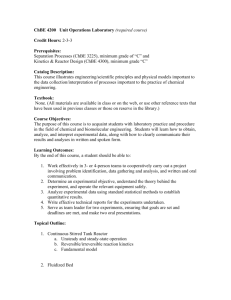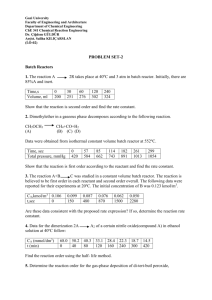handouts - WordPress.com
advertisement
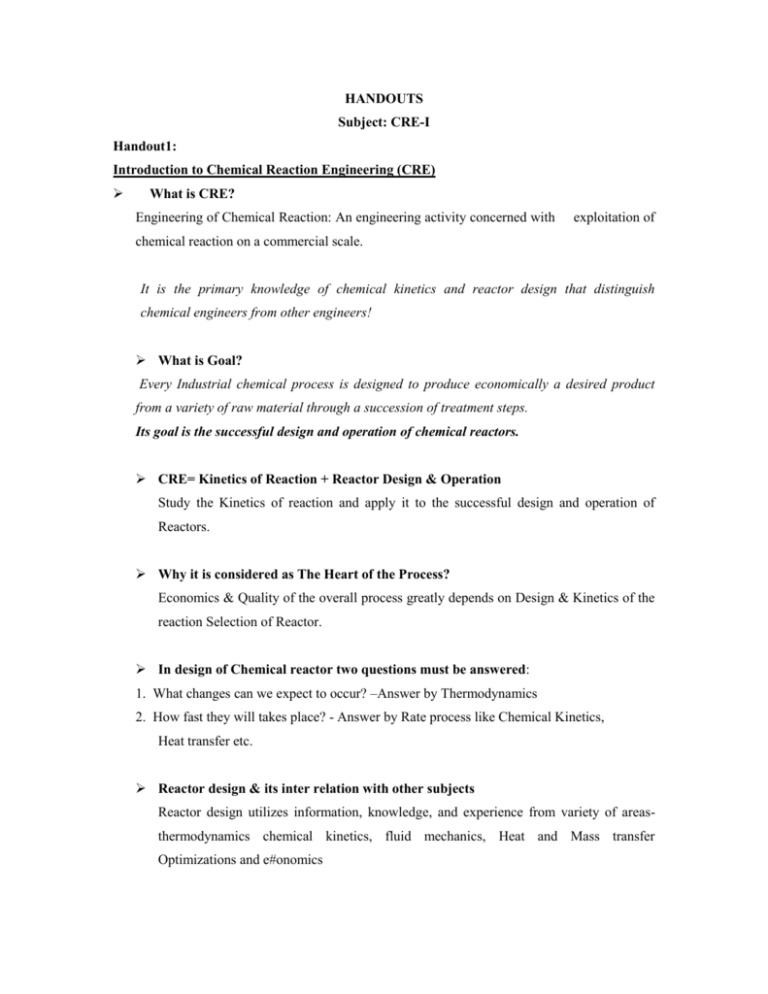
HANDOUTS Subject: CRE-I Handout1: Introduction to Chemical Reaction Engineering (CRE) What is CRE? Engineering of Chemical Reaction: An engineering activity concerned with exploitation of chemical reaction on a commercial scale. It is the primary knowledge of chemical kinetics and reactor design that distinguish chemical engineers from other engineers! What is Goal? Every Industrial chemical process is designed to produce economically a desired product from a variety of raw material through a succession of treatment steps. Its goal is the successful design and operation of chemical reactors. CRE= Kinetics of Reaction + Reactor Design & Operation Study the Kinetics of reaction and apply it to the successful design and operation of Reactors. Why it is considered as The Heart of the Process? Economics & Quality of the overall process greatly depends on Design & Kinetics of the reaction Selection of Reactor. In design of Chemical reactor two questions must be answered: 1. What changes can we expect to occur? –Answer by Thermodynamics 2. How fast they will takes place? - Answer by Rate process like Chemical Kinetics, Heat transfer etc. Reactor design & its inter relation with other subjects Reactor design utilizes information, knowledge, and experience from variety of areasthermodynamics chemical kinetics, fluid mechanics, Heat and Mass transfer Optimizations and e#onomics Important Information from Thermodynamics for reactor design: Heat of Reaction (delta H) Maximum possible extent of the reaction (from equilibrium constant K) Introduction to Chemical Kinetics And Classification of Chemical Reactions What is Chemical Kinetics? Kinetic =speed= Rate of chemical reaction. It includes: a) Measurement of rate of reaction b) Finding the factors affecting the rate of reactions (T, P,C etc) c) Effect of various factors on reaction rate & proposes explanations for the rate values found. For a chemical engineer the kinetics of the reaction must be known to satisfactorily design equipment to effect these reactions on the technical scale. Performance or Design Equation is function of Chemical Kinetics. Classification of Chemical Reactions Homogeneous Reaction: single phase involved Heterogeneous Reaction: More than one phase involved Catalytic Reactions and Non-Catalytic Reactions Variable affecting the Rate of Reaction Homogeneous reaction: Temperature, pressure &Composition only Heterogeneous Reaction: T, P,C and Transport rate(Heat &Mass transfer Rate) Definition of Rate of Reaction Rate is defined as rate of change of number of moles of the component of reaction mixture per unit base (B=V[ri],W[ri’],S[ri’’],Vs[ri’’’],Vr[ri’’’’]) ri=1/B dNi/dt So it is an Intensive property rather than extensive. Rate is also the function of the state of system. All measures of rate are interrelated as follows: V [ri]=W [ri’]=S [ri’’]=Vs [ri’’’]=Vr [ri’’’’] Order of reaction: The order of a reaction is simply the sum of the exponents on the concentration terms for a rate law: Rate = k [A]x [B]y reaction order = x + y Example 1: Rate = k [A] 1[B] 0 = k [A] is 1st order in [A] and 0th order in [B] and 1st order for the reaction. Example 2: Rate = k [A] 3[B] 0.5 is 3rd order in [A], half order in [B] and 3.5 order overall. We need to know the order of a reaction because it tells us the functional relationship between concentration and rate. It determines how the amount of a compound speeds up or retards a reaction. For example, a reaction order of three means the rate of reaction increases as the cube of the concentration. A reaction order of -1 means the compound actually retards the rate of reaction. Handout 2: Determination of rate Equation: Determination of Rate Expression: 2 step procedure 1. Concentration dependency is found at fixed temperature 2. Temperature dependence of rate constant. Determination of the constants of the rate equation: Two type of reactors are used for Experimental determination 1. Batch reactor 2. Flow reactor: Plug flow reactor And Mixed flow reactor. Procedure to Analyze kinetic data 1. Integral Method of analysis: General procedure: we guess a particular form of the rate expression after appropriate integration and mathematical manipulations and predict that the plot of certain concentration vs. time data should yield the straight line, then the rate equation is said to satisfactorily fit the data. 2. Differential Method of Analysis. Interpretation of Batch reactor Data Batch reactor classified as: b) Constant volume batch reactor: Constant density reaction system c) Variable volume batch reactor: Variable density reaction system Constant volume batch reactor: Constant density reaction system Analysis of total pressure data obtained in a constant volume system: expression, which relates change in total pressure of the system to change in total concentration or partial pressure of any component of reaction. Let the chemical reaction be represented by, a A + b B -> c C + d D then the rate is represented by any one of the following 1 d[A] 1 d[B] 1 d[C] 1 d[D] rate = - --- ---- = - --- ---- = --- ---- = --- ---a dt b dt c dt d dt Unless the rate expression is specified. Constant volume Batch reactor: Zero-order reactions A Zero-order reaction has a rate which is independent of the concentration of the reactant(s). Increasing the concentration of the reacting species will not speed up the rate of the reaction. Zero-order reactions are typically found when a material required for the reaction to proceed, such as a surface or a catalyst, is saturated by the reactants. The rate law for a zero-order reaction is where r is the reaction rate, and k is the reaction rate coefficient with units of concentration/time. If, and only if, this zero-order reaction 1) occurs in a closed system, 2) there is no net build-up of intermediates and 3) there are no other reactions occurring, it can be shown by solving a Mass balance for the system that: If this differential equation is integrated it gives an equation which is often called the integrated zero-order rate law Where represents the concentration of the chemical of interest at a particular time, and represents the initial concentration. A reaction is zero order if concentration data are plotted versus time and the result is a straight line. The slope of this resulting line is the negative of the zero order rate constant k. Derivations for First order Irreversible reactions: A first-order reaction depends on the concentration of only one reactant (a unimolecular reaction). Other reactants can be present, but each will be zero-order. The rate law for an elementary reaction that is first order with respect to a reactant A is, k is the first order rate constant, which has units of 1/time. The integrated first-order rate law is A plot of ln[A] vs. time t gives a straight line with a slope of − k. The half life of a first-order reaction is independent of the starting concentration and is given by . Examples of reactions that are first-order with respect to the reactant: Handout: 3 Second-order reactions A second-order reaction depends on the concentrations of one second-order reactant, or two first-order reactants. For a second order reaction, its reaction rate is given by: or The integrated second-order rate laws are respectively When initial concentration of both the reactants are same. Or [A]0 and [B]0 must be different, in order to obtain that integrated equation. Examples of a Second-order reaction Summary for reaction orders 0, 1, 2 and n Reactions with order 3 (called ternary reactions) are rare and unlikely to occur. Zero-Order First-Order Second-Order nth-Order Rate Law Integra ted Rate Law [Except first order] Units of Rate Consta nt (k) Linear Plot to determ ine k [Except first order] Halflife [Except first order] Where M stands for concentration (mol · L−1), t for time, and k for the reaction rate constant. Find order of reaction by half life method. Explain half life method and find for first and second order and sums based on half life. Handout 5, 6, 7: Irreversible reactions in Series: We first consider consecutive unimolecular first order reaction such as, if the rate constants for the following reaction are k1 and k2;, combining the rate equations with a mass balance for the system yields: Reaction rates For reactant A: For reactant B: For reactant C: Analytical Solutions The analytical solutions for these equations (supposing that initial concentrations of every substance except for A are zero) are: The analytical and approximated solutions should now be compared in order to decide when it is valid to use the steady state approximation. The analytical solution transforms into the approximate one when , because then and . Therefore it is valid to apply the steady state approximation only if the second reaction is much faster than the first one (k2/k1 > 10 is a right criterion), because that means that the intermediate forms slowly and reacts readily so its concentration stays low. The graphs show concentrations of A (red), B (green) and C (blue) in two cases, calculated from the analytical solution: When the first reaction is faster it is not valid to assume that the variation of [B] is very small, because [B] is neither low or close to constant: first A transforms into B rapidly and B accumulates because it disappears slowly. As the concentration of A decreases its rate of transformation decreases, at the same time the rate of reaction of B into C increases as more B is formed, so a maximum is reached when. From then on the concentration of B decreases. When the second reaction is faster, after a short induction period concentration of B remains low (and more or less constant) because its rate of formation and disappearance are almost equal and the steady state approximation can be used. Concentration vs. time. Concentration of intermediate in green, product in blue and substrate in red (k2 / k1 = 0.5) Concentration vs. time. Concentration of intermediate in green, product in blue and substrate in red (k2 / k1 = 10) Derivations for Parallel reactions, Homogeneous catalyzed reaction: k1 A R k2 A C RC dC A k1C A dt 1 dC A k2C ACC dt 2 dC A k1C A k2C ACC k1 k2CC C A dt The reaction would proceed even without a catalyst present and the rate of the catalyzed reaction is directly proportional to the catalyst concentration. Solve the sums based on above theories. Handout 8, 9, 10: Autocatalytic reactions. A R R R dC A kCAC R dt The total number of moles of A and R rA remain unchanged as A is consumed C0 C A C R C A0 C R 0 constant C R C0 C A rA ln dC A kCA C0 C A dt dC A 1 dC dC A kdt A C A C0 C A C0 C A C0 C A C A0 C0 C A C C ln R R0 C0 kt C A0 CR0 kt C A C0 C A0 C A C A0 Derivation for reversible reaction, find equilibrium concentration. Discuss the shifting order reaction and solve sums based on above theory. Handout 11, 12, 13, 14: Variable volume batch reactor: What do you mean by variable volume batch reactor? Introduction of ε, definition of ε. A VX A 1 VX A 0 VX A 0 Expansion factor - V0 initial volume of the reactor V the volume at time t V V0 1 ε A X A X A For example : V-V0 dV dX A V0 ε A V0 ε A A 4R starting with pure reactant A : A starting with 50% inert : A 4 1 3 1 52 1.5 2 Derivation for first order, second order, pseudo first order reactions. First-Order Reactions rA C dN A dV A0 kCA Vdt Vε A dt For C A C A 0 1-X A 1 εA X A so C A 0 dV 1 X A kCA 0 Vε A dt 1 εA X A Replacing X A by V V0 1 ε A X A dV k V0 A V V0 t 0, V V0 dt V Integratin g gives : ln 1 kt and ΔV V-V0 V 0 A Comparison between Differential method and Integral method of analysis. Solve the sums based on variable volume reactors. Handout 15: Introduction to reactor design: Ideal reactor types: Batch reactor (BR), Continuously stirred tank reactor (CSTR), Plug flow reactor (PFR) Handout 16: Discuss the distinct features of CSTR Discuss Space time and Space velocity Handout 17, 18: Handout 19, 20, 21, 22: Handout 23, 24, 25: Comparison of CSTR vs. PFR For a given duty the ratio of sizes of CSTR & PFR will depend on: extent of reaction stoichiometry form of the rate equation For nth order reaction & for identical CA0 & FA0 M P 1 x n A A x A 1 x A M V M VP x A 1 x n A A dx A 0 1 x A P For all reactions of order > 0, the CSTR is always larger than the PFR For Zero order the size is same The ratio of volumes increases with order At small conversions, the ratio of volumes approach unity The ratio increases very rapidly at high conversion Density variation also effects the ratio – secondary influence Expansion / density decrease - increases the volume ratio Contraction / density increase - decreases the volume ratio PFR in series & Parallel: Handout 26, 27, 28, 29: CSTR in Series: C0 (1 k i ) N CN Different Reactors in series: Discuss different reactors in series: Two CSTR in series, PFR and CSTR in series, compare volume of reactor require and discus comparison. Summery: For reactions of orders > 0, they should be ordered so as to keep the concentration as high as possible. For reactions of orders < 0, they should be ordered so as to keep the concentration as low as possible. If the rate vs. concentration curve passes through a maxima or minima, the arrangement would depend on the actual shape, concentration level desired. No generalized rule can be suggested. Recycle Reactors: Define Recycle ratio R, derivation, Autocatalytic reaction and sums based on each theory. Solve sums based on different reactors in series and compare volume of different arrangements.




